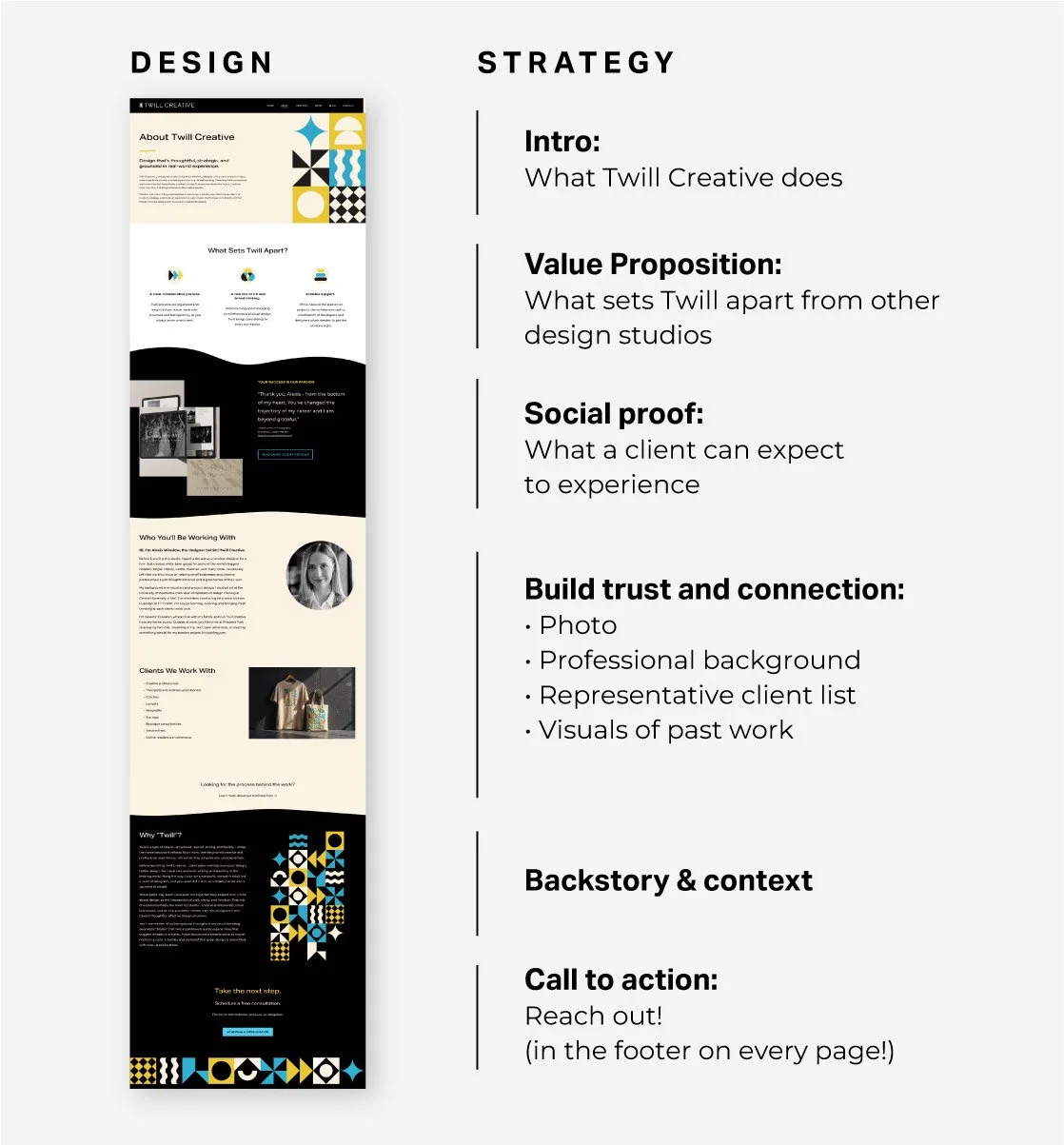What to Put on Your About Page (And Why It Matters)
The About page is one of the most misunderstood sections of a website. Some of my clients feel pressure to get deeply personal (sharing everything from childhood aspirations to quirky hobbies) while others don’t understand how it’s any different from a Home or Services page.
Here’s the truth: Your About page is a strategic opportunity to build trust and deepen connection with your visitors. It’s not just about you. It’s about why you’re the right fit for them.
Why the About Page Matters
According to a 2023 study by KoMarketing, 52% of website visitors want to see an About page when they land on a new business site—and if they can’t find it, they’re more likely to leave. Your About page gives you the chance to:
Humanize your brand
Reinforce your value proposition
Build credibility and emotional rapport
Highlight what makes you different
This is especially important for small organizations, solo professionals, and consultants where the decision to hire you is personal. People want to know who they’re working with. And they want to feel confident in that choice.
The Role of the About Page in the User Journey
Your About page sits between curiosity and commitment. By the time someone clicks “About,” they’re interested. They’re looking to answer questions like:
Who are you?
Can I trust you?
What’s your story?
Do your values align with mine?
What experience do you bring?
In a well-designed site, this page complements your homepage and services pages. It reinforces what makes your business credible and makes the visitor feel understood.
What to Include on an Effective About Page
When visitors land on your About page, they’re often trying to get a feel for what it might be like to work with you. This is especially true for service-based businesses where the relationship is key.
I share a PDF guide on this topic with all of my Rapid Website clients. Here’s a breakdown of the top elements that consistently work:
1. Start with Your Value Proposition
Don’t bury the lead. Open your About page with a short, clear summary of what you do and why it matters to your audience. Think of it as a quick refresh of your elevator pitch, adapted for the web.
2. Tell a Relevant Story
Your origin story, company background, or personal journey can go here—but tie it back to your client. Why did you start this business? What problem were you solving? Why does that matter now?
3. Share Your Values or Philosophy
People want to work with businesses whose values align with their own. Whether it’s a commitment to transparency, creative exploration, or client-first service, SPELL IT OUT.
4. Showcase Your Credentials
This can include bios, awards, certifications, or recognizable brand names you’ve worked with. Even stats (like years in business or number of clients served) count as social proof.
If your organization includes a team, consider linking to individual bios on separate pages. This allows the main About page to stay streamlined while still giving visitors the option to learn more about each team member’s background and role.
5. Use Visuals to Build Trust
Photos of you, your team, or your workspace help make a personal connection. Don’t overthink it—authentic, friendly images go a long way.
6. Make It Skimmable
Use subheadings, bullet points, and bolded phrases to guide the reader. Avoid long blocks of text.
7. Include a Testimonial or Review
A well-placed testimonial can go a long way toward easing a visitor’s hesitation. If someone is trying to understand what it’s like to work with you, a short, specific client quote about your process or results can serve as powerful reassurance. Consider placing a review that reflects the tone and style of your services near your bio or values section where a visitor is already primed to build trust.
And if your business collects star ratings on platforms like Google or Clutch, don’t hesitate to display them. A high rating can signal trust and quality at a glance, especially for visitors scanning the page for quick validation.
8. Include a CTA (Call to Action)
Whether it’s “Book a Consult,” “Read Our Services,” or just a “Let’s Talk” button—give visitors a clear next step.
How We Do It At Twill Creative: Rapid Websites vs. Custom Builds
When I build Rapid Websites, I help clients choose which elements from the list above make the most sense for their business. I provide the guide and a content planner so they can fill in their story at their own pace.
For Custom Website projects, I work one-on-one with each client to decide what kind of About page will support their goals. That might mean structuring the content across multiple pages under a single "About" category in the site navigation—particularly helpful for larger organizations or firms with multiple team members. This allows each section (e.g., firm history, team bios, philosophy) to have its own space, creating a cleaner, more digestible user experience.
This might include elements like a team timeline or brand history to help visitors understand how the firm has evolved. For firms with multiple practitioners, we might create individual bios with downloadable CVs or linked pages for each team member. A "note from the founder" or short video intro can also add a warm, human touch—especially valuable for solo professionals or firms looking to personalize their brand.
We let the content strategy drive the design.
Examples of Strong About Page Additions
These optional elements don’t belong on every About page, but when used thoughtfully, they can add meaningful depth, especially on custom sites or for service providers where trust and authority matter most.
A List of Clients or Representative Experience: Law firms I work with often worry about compliance, so we use a "Representative Experience" section instead of naming clients. Example: “Advised art consultant on sale and commission agreements.” It’s discreet but powerful.
Mini Case Studies: These are a great way to build authority. For more on how to write them ethically, check out this post on law firm case studies.
Accolades, Awards and Logos: Don’t be shy—this is a perfect place to mention recognitions, certifications, or impressive client logos.
Founder’s Note: A brief paragraph in the founder’s voice can reinforce warmth and personality, especially for solo businesses.
Real-World Examples
Want to see some About pages in action? Here are a few examples from recent projects:
This was a custom site for a solo professional. This page strikes a great balance of credibility, personality, and professionalism. You really get a sense of what makes Christine and her work special.
This was a custom site for a law firm. It’s a great example of an "About" section broken into multiple pages. Each part of the firm’s story has its own space, which helps with clarity and usability.
This was a Rapid Website project where just a few elements—a strong portrait, awards and affiliations, a brief backstory, and credentials— all come together to create an impactful About page without overwhelming the reader.
Each one of the examples above reflects a different strategy based on the client’s goals, business size, and audience. You can find more examples like these in my Custom Website Showcase, where you can see how different design approaches serve different client needs.
Below is a breakdown of the content that I put on this website’s About page. You can see how the narrative structure of the page, from top to bottom, builds confidence in my services and ultimately a connection with my ideal client.
Takeaways
Your About page should reinforce your brand and speak directly to your target audience
Include only what’s relevant to the client’s decision-making process—cut the fluff
Tailor the tone and structure to match the rest of your site and brand voice
Use the page to build rapport and confidence, not just list credentials
Need help building or refining your About page? Get in touch! At Twill Creative, I specialize in helping small organizations and solo professionals craft messaging and visuals that connect. Whether it’s part of a Rapid Website sprint or a fully custom site, I’ll help you turn your story into something strategic.





